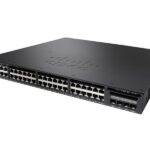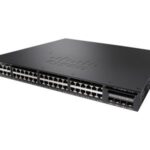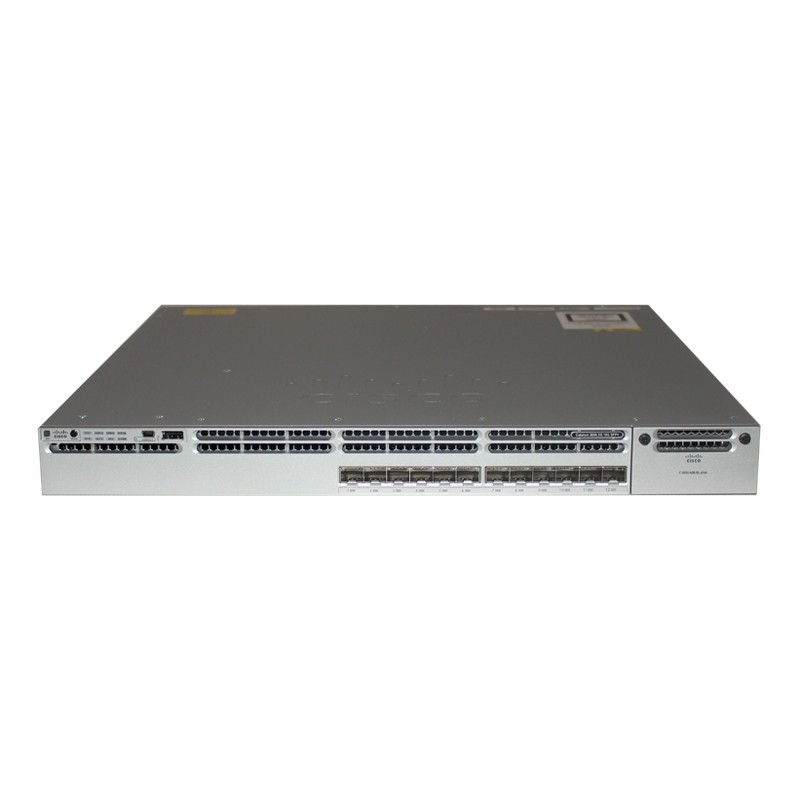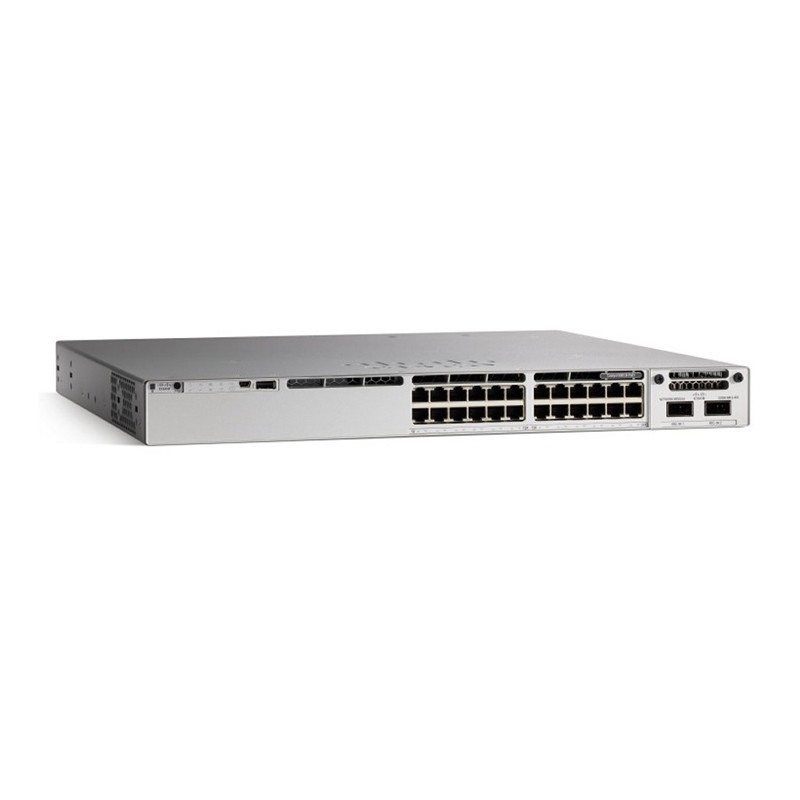

N5K-C5596UP-FA
$46,000.00 Original price was: $46,000.00.$9,949.00Current price is: $9,949.00.
| Model: |
N5K-C5596UP-FA Datasheet – Cisco Nexus 5000 Series Switch |
Detail: |
Nexus 5596UP 2RU Chassis, with 2PS, 4 Fans, 48 Fixed 10GE Ports |
Cisco ONE Nexus 5596UP 2RU, 2PS, 4 Fans, 48 Fixed Ten GE Ports. The Cisco Nexus 5596UP switch conveys progressed building adaptability, framework straightforwardness, and business spryness with help for systems administration principles. For customary, virtualized, brought together and superior figuring conditions it offers different IT and business benefits with Gear Net Technologies.
Main Features
Switch
managed
10 GE Ports
rack-mountable
PDF Attachment:
- Description
Description
n5k-c5596up-fa datasheet
N5K-C5596UP-FA Datasheet Specifications |
|
| Performance N5K-C5596UP-FA | ● Layer 2 hardware forwarding at 1920 Gbps or 1428 mpps; Layer 3 performance of up to 160 Gbps or 240 mpps
● MAC address table entries: 32,000 ● Low-latency cut-through design that provides predictable, consistent traffic latency regardless of packet size, traffic pattern, or enabled features on 10 Gigabit Ethernet interfaces ● Line-rate traffic throughput on all ports |
| Interfaces N5K-C5596UP-FA | ● 48 fixed ports configurable as 1 and 10 Gigabit Ethernet and FCoE or 8/4/2/1-Gbps native Fibre Channel; additional interfaces through up to three expansion modules
● Expansion modules ● 16-port 1 and 10 Gigabit Ethernet and FCoE module ● 8-port 8/4/2/1-Gbps Fibre Channel plus 8-port 1 and 10 Gigabit Ethernet and FCoE module ● Unified port module consisting of 16 ports configurable as 8/4/2/1-Gbps Fibre Channel or 1 and 10 Gigabit Ethernet and FCoE ● 4-port QSFP expansion module ● 12-port 10G BASE-T module (Cisco Nexus 5596T only) ● Layer 3 module (Cisco Nexus 5596UP and 5596T only; one per system) ● Layer 3 daughter card (Cisco Nexus 5548P and 5548UP only; one per system) ● Extension through the Cisco Nexus 2000 Series |
| N5K-C5596UP-FA | |
| Layer 2 Features | ● Layer 2 switch ports and VLAN trunks
● IEEE 802.1Q VLAN encapsulation ● Support for up to 4096 VLANs ● Rapid Per-VLAN Spanning Tree Plus (PVRST+) (IEEE 802.1w compatible) ● Multiple Spanning Tree Protocol (MSTP) (IEEE 802.1s): 64 instances ● Spanning Tree PortFast ● Spanning Tree root guard ● Spanning Tree Bridge Assurance ● Cisco EtherChannel technology (up to 16 ports per EtherChannel) ● Cisco vPC technology ● Enhanced vPC enable vPC between Cisco Nexus 5000 and 2000 Series as well as between Cisco Nexus 3000 Series and end host ● vPC configuration synchronization ● Link Aggregation Control Protocol (LACP): IEEE 802.3ad ● Advanced port channel hashing based on Layer 2, 3, and 4 information ● Jumbo frames on all ports (up to 9216 bytes) ● Pause frames (IEEE 802.3x) ● Storm control (unicast, multicast, and broadcast) ● Private VLANs ● Private VLAN over trunks (isolated and promiscuous) ● Private VLANs over vPC and EtherChannels ● VLAN Remapping ● Cisco FabricPath ● EvPC and vPC+ with FabricPath ● Cisco Adapter FEX ● Cisco Data Center VM FEX ● Support for up to 24 fabric extenders on each Cisco Nexus 5500 platform |
| N5K-C5596UP-FA | |
| Layer 3 Features | ● Layer 3 interfaces: Routed ports on Cisco Nexus 5500 platform interfaces, switch virtual interface (SVI), port channels, subinterfaces, and port channel subinterfaces for a total of 4096 entries
● Support for up to 8000 prefixes and up to 16000 IPv4 and 8000 IPv6 host entries ● Support for up to 8000 multicast routes ● Support for up to 8000 IGMP groups ● Support for 1000 VRF entries ● Support for up to 4096 VLANs ● 16-way equal-cost multipathing (ECMP) ● 1664 ingress and 2048 egress access control list (ACL) entries ● Routing protocols: Static, Routing Information Protocol Version2 (RIPv2), Enhanced Interior Gateway Routing Protocol (EIGRP), Open Shortest Path First Version 2 (OSPFv2), and Border Gateway Protocol (BGP) ● IPv6 Routing Protocols: Static, Open Shortest Path First Version 3 (OPFv3), Border Gateway Protocol (BGPv6), Enhanced Interior Gateway Routing Protocol (EIGRPv6) ● IPv6 VRF Lite ● Hot-Standby Router Protocol (HSRP) and Virtual Router Redundancy Protocol (VRRP) ● ACL: Routed ACL with Layer 3 and 4 options to match ingress and egress ACL ● Multicast: Protocol Independent Multicast Version 2 (PIMv2) sparse mode, Source Specific Multicast (SSM), Multicast Source Discovery Protocol (MSDP), Internet Group Management Protocol Versions 2, and 3 (IGMP v2, and v3), and Multicast VLAN Registration (MVR) ● Virtual Route Forwarding (VRF): VRF-lite (IP VPN); VRF-aware unicast; and BGP-, OSPF-, RIP-, and VRF-aware multicast ● Unicast Reverse Path Forwarding (uRFP) with ACL; strict and loose modes ● Jumbo frame support (up to 9216 bytes) ● Support for up to 16 fabric extender on each Nexus 5500 with L3 modules ● RFC 896 |
| QoS N5K-C5596UP-FA | ● Layer 2 IEEE 802.1p (CoS)
● 8 hardware queues per port ● Per-port QoS configuration ● CoS trust ● Port-based CoS assignment ● Modular QoS CLI (MQC) compliance – IPv4 and IPv6 ● ACL-based QoS classification (Layers 2, 3, and 4) ● MQC CoS marking ● Per-port virtual output queuing ● CoS-based egress queuing ● Egress strict-priority queuing ● Egress port-based scheduling: Weighted Round-Robin (WRR) ● Control Plan Policing (CoPP) – IPv4 and IPv6 |
| Security | ● Ingress ACLs (standard and extended) on Ethernet and virtual Ethernet ports
● Standard and extended Layer 2 ACLs: MAC addresses, protocol type, etc. ● Standard and extended Layer 3 to 4 ACLs: IPv4 and IPv6, Internet Control Message Protocol (ICMP and ICMPv6), TCP, User Datagram Protocol (UDP), etc. ● VLAN-based ACLs (VACLs) ● Port-based ACLs (PACLs) ● Named ACLs ● Optimized ACL distribution ● ACLs on virtual terminals (VTYs) ● ACL logging on management interface ● Dynamic Host Configuration Protocol (DHCP) snooping with Option 82 ● Dynamic Address Resolution Protocol (ARP) Inspection ● IP source guard ● DHCP relay ● Cisco CTS (Authentication and Policy download from ACS) ● Ethernet Port Security ● IPv6 RACL ● IPv6 PACL ● IPv6 VACL |
| High-Availability Features | ● In-Service Software Upgrade (ISSU) for Layer 2
● Hot-swappable field-replaceable power supplies, fan modules, and expansion modules ● 1:1 power redundancy ● N:1 fan module redundancy |
| Management | ● Switch management using 10/100/1000-Mbps management or console ports
● CLI-based console to provide detailed out-of-band management ● In-band switch management ● Locator and beacon LEDs on Cisco Nexus 2000 Series ● Port-based locator and beacon LEDs ● Configuration synchronization ● Module preprovisioning ● Configuration rollback ● Secure Shell Version 2 (SSHv2) ● Telnet ● AAA ● AAA with RBAC ● RADIUS ● TACACS+ ● Syslog (8 servers) ● Embedded packet analyzer ● SNMPv1, v2, and v3 (IPv4 & IPv6) ● Enhanced SNMP MIB support ● XML (NETCONF) support ● Remote monitoring (RMON) ● Advanced Encryption Standard (AES) for management traffic ● Unified username and passwords across CLI and SNMP ● Microsoft Challenge Handshake Authentication Protocol (MS-CHAP) ● Digital certificates for management between switch and RADIUS server ● Cisco Discovery Protocol Versions 1 and 2 ● RBAC ● Switched Port Analyzer (SPAN) on physical, port channel, VLAN, and Fibre Channel interfaces ● Encapsulated Remote SPAN (ERSPAN) ● Ingress and egress packet counters per interface ● Network Time Protocol (NTP) ● Cisco GOLD ● Comprehensive bootup diagnostic tests ● Call Home ● Smart Call Home ● Cisco Fabric Manager ● Cisco DCNM ● CiscoWorks LAN Management Solution (LMS) |
| Data Center Bridging | ● CEE- and IEEE-compliant PFC (per-priority Pause frame support)
● PFC link distance support: 3000m ● CEE-compliant DCBX Protocol ● CEE- and IEEE-compliant Enhanced Transmission Selection |
| Fibre Channel and FCoE Features (Requires Storage Services License) | ● T11 standards-compliant FCoE (FC-BB-5)
● T11 FCoE Initialization Protocol (FIP) (FC-BB-5) ● Any 10 Gigabit Ethernet port configurable as FCoE ● SAN administration separate from LAN administration ● FCP ● Fibre Channel forwarding (FCF) ● Fibre Channel standard port types: E, F, and NP ● Fibre Channel enhanced port types: VE, TE, and VF ● F-port trunking ● F-port channeling ● Direct attachment of FCoE and Fibre Channel targets ● Up to 240 buffer credits per native Fibre Channel port ● Up to 32 VSANs per switch ● Fibre Channel (SAN) port channel ● Native Interop Mode 1 ● Native Interop Mode 2 ● Native Interop Mode 3 ● Native Interop Mode 4 ● VSAN trunking ● Fabric Device Management Interface (FDMI) ● Fibre Channel ID (FCID) persistence ● Distributed device alias services ● In-order delivery ● Port tracking ● Cisco N-Port Virtualization (NPV) technology ● N-port identifier virtualization (NPIV) ● Fabric services: Name server, registered state change notification (RSCN), login services, and name-server zoning ● Per-VSAN fabric services ● Cisco Fabric Services ● Diffie-Hellman Challenge Handshake Authentication Protocol (DH-CHAP) and Fibre Channel Security Protocol (FC-SP) ● Distributed device alias services ● Host-to-switch and switch-to-switch FC-SP authentication ● Fabric Shortest Path First (FSPF) ● Fabric binding for Fibre Channel ● Standard zoning ● Port security ● Domain and port ● Enhanced zoning ● SAN port channels ● Cisco Fabric Analyzer ● Fibre Channel traceroute ● Fibre Channel ping ● Fibre Channel debugging ● Cisco Fabric Manager support ● Storage Management Initiative Specification (SMI-S) ● Boot from SAN over VPC/EVPC |
| Generic MIBs | ● SNMPv2-SMI
● CISCO-SMI ● SNMPv2-TM ● SNMPv2-TC ● IANA-ADDRESS-FAMILY-NUMBERS-MIB ● IANAifType-MIB ● IANAiprouteprotocol-MIB ● HCNUM-TC ● CISCO-TC ● SNMPv2-MIB ● SNMP-COMMUNITY-MIB ● SNMP-FRAMEWORK-MIB ● SNMP-NOTIFICATION-MIB ● SNMP-TARGET-MIB ● SNMP-USER-BASED-SM-MIB ● SNMP-VIEW-BASED-ACM-MIB ● CISCO-SNMP-VACM-EXT-MIB |
| Layer 3 MIBs | ● UDP-MIB
● TCP-MIB ● OSPF-MIB ● BGP4-MIB ● CISCO-HSRP-MIB |
| Fibre Channel MIBs | ● CISCO-ST-TC
● CISCO-FC-FE-MIB ● CISCO-FCSP-MIB ● CISCO-PORT-TRACK-MIB ● CISCO-PSM-MIB ● CISCO-FC-SPAN-MIB ● CISCO-PORT-CHANNEL-MIB ● CISCO-RSCN-MIB ● CISCO-NS-MIB ● CISCO-FCS-MIB ● CISCO-DM-MIB ● FIBRE-CHANNEL-FE-MIB ● CISCO-FC-ROUTE-MIB ● CISCO-FSPF-MIB ● CISCO-ZS-MIB ● CISCO-ZS-EXT-MIB ● CISCO-VSAN-MIB ● CISCO-CFS-MIB ● CISCO-FCPING-MIB ● CISCO-FCTRACEROUTE-MIB ● CISCO-FDMI-MIB ● CISCO-FC-DEVICE-ALIAS-MIB ● CISCO-WWNMGR-MIB ● FCMGMT-MIB ● CISCO-VEDM-MIB ● CISCO-FCOE-MIB |
| Ethernet MIBs | ● CISCO-VLAN-MEMBERSHIP-MIB
● CISCO-Virtual-Interface-MIB |
| Configuration MIBs | ● ENTITY-MIB
● IF-MIB ● CISCO-ENTITY-EXT-MIB ● CISCO-ENTITY-FRU-CONTROL-MIB ● CISCO-ENTITY-SENSOR-MIB ● CISCO-FLASH-MIB ● CISCO-SYSTEM-MIB ● CISCO-SYSTEM-EXT-MIB ● CISCO-IP-IF-MIB ● CISCO-IF-EXTENSION-MIB ● CISCO-SERVER-INTERFACE-MIB ● CISCO-NTP-MIB ● CISCO-IMAGE-MIB ● CISCO-IMAGE-CHECK-MIB ● CISCO-IMAGE-UPGRADE-MIB ● CISCO-CONFIG-COPY-MIB ● CISCO-ENTITY-VENDORTYPE-OID-MIB ● CISCO-BRIDGE-MIB |
| Monitoring MIBs | ● DIFFSERV-DSCP-TC
● NOTIFICATION-LOG-MIB ● DIFFSERV-MIB ● CISCO-CALLHOME-MIB ● CISCO-SYSLOG-EXT-MIB ● CISCO-PROCESS-MIB ● RMON-MIB ● CISCO-RMON-CONFIG-MIB ● CISCO-HC-ALARM-MIB |
| Security MIBs | ● CISCO-AAA-SERVER-MIB
● CISCO-AAA-SERVER-EXT-MIB ● CISCO-COMMON-ROLES-MIB ● CISCO-COMMON-MGMT-MIB ● CISCO-RADIUS-MIB ● CISCO-SECURE-SHELL-MIB ● TCP/IP MIBs ● INET-ADDRESS-MIB ● TCP-MIB ● CISCO-TCP-MIB ● UDP-MIB ● IP-MIB ● CISCO-IP-PROTOCOL-FILTER-MIB ● CISCO-DNS-CLIENT-MIB ● CISCO-PORTSECURITY- MIB |
| Miscellaneous MIBs | ● START-MIB
● CISCO-LICENSE-MGR-MIB ● CISCO-FEATURE-CONTROL-MIB ● CISCO-CDP-MIB ● CISCO-RF-MIB ● CISCO-ETHERNET-FABRIC-EXTENDER-MIB ● CISCO-BRIDGE-MIB |
| Industry Standards | ● IEEE 802.1D: Spanning Tree Protocol
● IEEE 802.1p: CoS prioritization ● IEEE 802.1Q: VLAN tagging ● IEEE 802.1Qaz: Enhanced transmission selection ● IEEE 802.1Qbb: Per-priority Pause ● IEEE 802.1s: Multiple VLAN instances of Spanning Tree Protocol ● IEEE 802.1w: Rapid reconfiguration of Spanning Tree Protocol ● IEEE 802.3: Ethernet ● IEEE 802.3ad: LACP with fast timers ● IEEE 802.3ae: 10 Gigabit Ethernet ● SFF 8431 SFP+ CX1 support ● RMON ● IEEE 1588-2008: Precision Time Protocol (Boundary Clock) |
| Fibre Channel Standards | ● FC-PH, Revision 4.3 (ANSI/INCITS 230-1994)
● FC-PH, Amendment 1 (ANSI/INCITS 230-1994/AM1 1996) ● FC-PH, Amendment 2 (ANSI/INCITS 230-1994/AM2-1999) ● FC-PH-2, Revision 7.4 (ANSI/INCITS 297-1997) ● FC-PH-3, Revision 9.4 (ANSI/INCITS 303-1998) ● FC-PI, Revision 13 (ANSI/INCITS 352-2002) ● FC-PI-2, Revision 10 (ANSI/INCITS 404-2006) ● FC-PI-4, Revision 7.0 ● FC-FS, Revision 1.9 (ANSI/INCITS 373-2003) ● FC-FS-2, Revision 0.91 ● FC-LS, Revision 1.2 ● FC-SW-2, Revision 5.3 (ANSI/INCITS 355-2001) ● FC-SW-3, Revision 6.6 (ANSI/INCITS 384-2004) ● FC-GS-3, Revision 7.01 (ANSI/INCITS 348-2001) ● FC-GS-4, Revision 7.91 (ANSI/INCITS 387-2004) ● FC-BB-5, Revision 2.0 for FCoE ● FCP, Revision 12 (ANSI/INCITS 269-1996) ● FCP-2, Revision 8 (ANSI/INCITS 350-2003) ● FCP-3, Revision 4 (ANSI/INCITS 416-2006) ● FC-MI, Revision 1.92 (INCITS TR-30-2002, except for FL-ports and Class 2) ● FC-MI-2, Revision 2.6 (INCITS TR-39-2005, except for FL-ports and Class 2) ● FC-SP, Revision 1.6 ● FC-DA, Revision 3.1 (INCITS TR-36-2004, except for FL-ports, SB-ports and Class 2) ● Class of Service: Class 3, Class F ● Fibre Channel standard port types: E and F ● Fibre Channel enhanced port types: SD and TE |
|
Physical Specifications |
|
| SFP+ Optics | Cisco Nexus 5500 platform supports 10 Gigabit Ethernet SFP+ copper Twinax cables for short distances and SFP+ optics (10GBASE-SR, 10GBASE-LR, 10GBASE-ER, GLC-ZX-SM and Cisco Nexus 2000 Series Fabric Extender Transceiver [FET-10G]) for longer distances. SFP+ has several advantages compared to other 10 Gigabit Ethernet connectivity options:
● Small 10 Gigabit Ethernet form factor ● Optical interoperability with XENPAK, X2, and XFP interface types ● Low power consumption ● Hot-swappable device ● Cisco Nexus 5500 platform products support 8-Gbps Fibre Channel-compatible SFP+ for native Fibre Channel connectivity options; 8-Gbps Fibre Channel-compatible short-reach and 10-km long-reach SFP transceiver modules operate at 8/4/2 Gbps and are supported in the 8‑Gbps-capable native Fibre Channel ports on expansion modules and unified ports |
| Physical (height x width x depth) | 3.47 x 17.3 x 29.5 in. (8.8 x 43.9 x 74.9 cm) |
| Operating temperature | 32 to 104°F (0 to 40°C) |
| Nonoperating (storage) temperature | -40 to 158°F (-40 to 70°C) |
| Humidity | 5 to 95% (noncondensing) |
| Altitude | 0 to 10,000 ft (0 to 3000m) |
| Weight | 47.5 lb (21.55 kg) |









